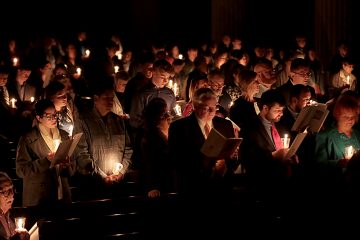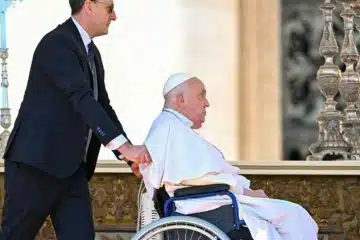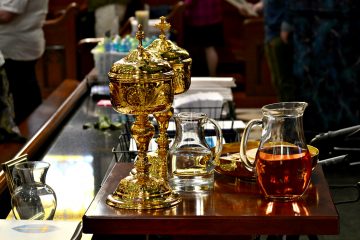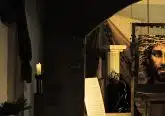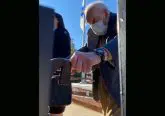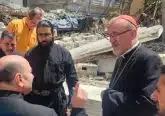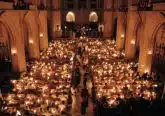U.S. pilgrims count their blessings, pray for peace after escaping Holy Land
CNA Staff, Oct 19, 2023 / 12:30 pm
Father Björn Lundberg was looking forward to his trip to Israel. A parish priest of the Diocese of Arlington, Virginia, Lundberg hadn’t set foot in the Holy Land since last going on pilgrimage there in 2009.
After 14 years, he was excited to lead a group of 50 or so American pilgrims to the areas where Christ himself walked, with an itinerary calling for six nights in Jerusalem, three nights on the Sea of Galilee, and numerous day trips to other famous biblical sites.
But the trip, several days in, was to take a dramatic turn.
During Mass Oct. 7 at a church near the Garden of Gethsemane, the pilgrims heard the thundering of artillery outside. Lundberg, who grew up hearing artillery exercises on an army base, wondered if what they were hearing was normal.
Later they learned that they were hearing the Israeli “Iron Dome” anti-missile defenses. The terrorist group Hamas had launched a surprise attack on Israel, sparking a retaliation that has devolved into a brutal war that is currently raging, with an estimated death toll on both sides approaching 5,000 as of Wednesday.
Through heavy traffic, the U.S. pilgrims were hurried back to their lodging place, the Notre Dame of Jerusalem Center, a grand 140-room hostel that offers hospitality to pilgrims from all over the world. The group sheltered in place and many set about praying in the center’s adoration chapel.
The next day, Lundberg said most of the group left the hostel — with the understanding that they were doing so at their own risk — to visit the Church of the Holy Sepulchre, the traditional site of Christ’s death and resurrection, which was very close by.
“[The streets are] usually very chaotic, and it was strange. It was very much like a ghost town because you’re walking down there, everything’s closed. There were a couple of places that were open, but essentially, nothing was open,” Lundberg recalled.
“It was very eerie, but it was very peaceful and quiet and we felt really secure.”
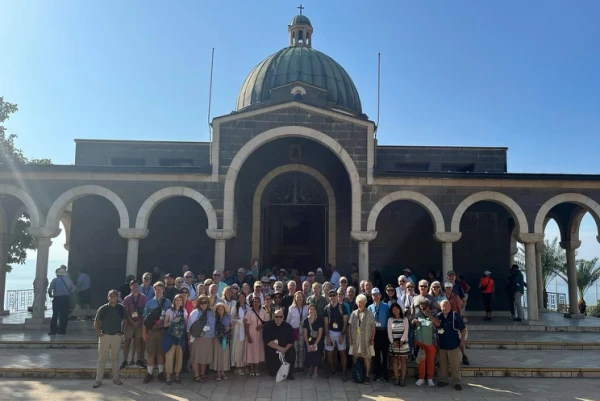
Unlike the streets, the Sepulchre was full of people, he said. Over the next few days, more of the pilgrims from Arlington made the short walk to the Sepulchre, but for the most part the group stayed sheltered in the hostel.
“During this time, efforts were being made by the tour company back in the United States and others to try to get us booked on flights out, because our original flights were either being changed and/or canceled and then delayed,” Lundberg explained.
“And we weren’t sure whether Tel Aviv was going to be a possibility to fly out of. So we ended up getting flights [booked] out of Jordan, out of Amman, through Dubai, back to Washington.”
Getting to Jordan was easier said than done, though. The pilgrims endured an hourslong bus ride, punctuated by numerous security checkpoints, one of which involved all the pilgrims disembarking the bus, unloading all their luggage, passing through a security screening, and getting back on.
(Other U.S. pilgrimage groups had even longer ordeals at security checkpoints, with one 84-member Catholic group from Fargo reporting being held up for seven and a half hours.)
Finally, the Arlington group made it out of Jordan and flew onward to Dubai before settling in, bleary-eyed, for the 14-hour flight back to Washington, D.C.
Throughout the process, thanks to it being “quite a good group of people,” Lundberg said the mood was positive among the pilgrims. He said they were generally able to stay connected with their family members back home and that the tour company handled the situation deftly.
That’s not to say that there weren’t moments of fear or doubt.
“I had some of my own moments in front of the tabernacle with Our Lord where I was kind of like, ‘Okay, what are we going to do here, Lord?’” the priest said.
“[But] there were so many people praying for us, that while there were certainly moments where we had questions, the group as a whole was really cohesive … things were changing moment to moment, hour to hour in the last two days in terms of finding out what were our possibilities for travel. So there was conversation that was going on, but it never devolved.”
“We were going to Mass together every day, we were praying together, we were eating together, we were going on some of these even small trips or exhibits together,” he continued.
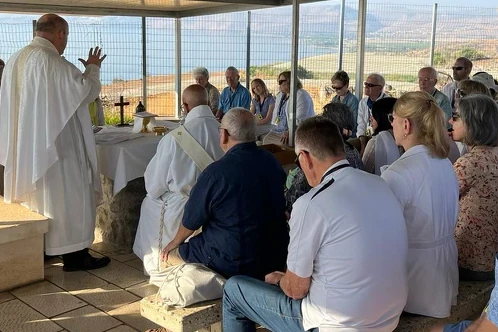
Back home in the U.S., Lundberg said he is very cognizant of the fact that the people who are native to the Holy Land have a hard road ahead of them. If nothing else, pilgrims from abroad will likely stay away for a while from the area, where tourism is the lifeblood.
“I was thinking, ‘Wow, these poor people.’ I mean, their whole life is going to be disrupted. We’re trying to get home. This is their home, and life will change for the near future in a really radical way,” Lundberg said.
‘A lot of uncertainty’
Many American Catholics who live and work in the Holy Land remain there with no plans to leave despite the uncertainty of the present moment. These include those who live at the hostel where Lundberg’s group stayed, the Notre Dame of Jerusalem Center.
Located just outside the Old City, the center was founded in the late 19th century as a refuge for French pilgrims and today, under the auspices of the Vatican, welcomes pilgrims from all over the world.
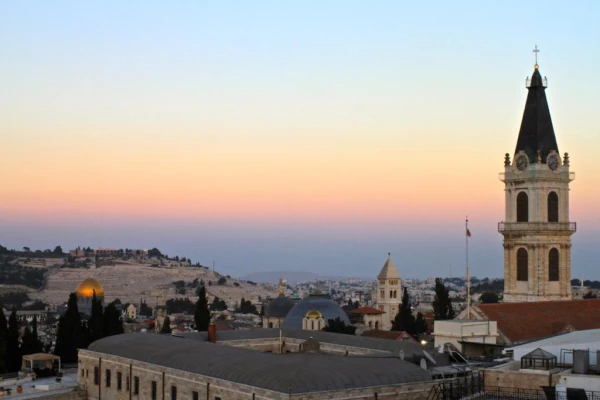
In an Oct. 13 email newsletter, Father David Steffy, LC, a Michigander and director of the center, said although the center itself “has been a place of safety and calm,” the situation in the Holy Land “is dire and no one knows what will develop in the next days, weeks, and months.”
“We truly appreciate your concern and prayers,” Steffy wrote.
“For the last several days our focus has been on helping the pilgrims find ways to get back home since many of the flights have been canceled. The witness of faith amongst the pilgrims and our staff in the midst of the turmoil has been inspirational.”
Steffy told CNA on Wednesday morning that many of the center’s staff are Christians from Jerusalem and from the West Bank, some of whom have had difficulty traveling in for work, forcing the center to limit some of its services.
“There’s a great faith amongst our employees, a faith that’s truly based on trust in the Lord,” Steffy told CNA. They have about a third of their typical staff still working as of Wednesday, he said.
The goal is to keep the center open, despite the challenges, he said.
“Notre Dame has always been sort of a stronghold. Maybe the word is more of a symbol of the Christian community, and the strength of the Christian community here, just outside of the Old City,” Steffy explained.
“Notre Dame has been very much a central part of the Christian community for so long, and also internationally because it’s brought pilgrims. So it’s also helped the local community of Christians feel supported by the international community … it’s a place where many Americans get to know a little bit more about the local culture and can experience a little bit of what the Christian situation in the Holy Land is.”
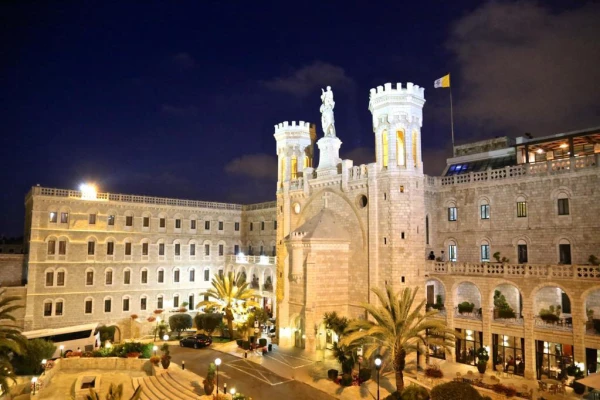
Steffy echoed Lundberg’s concerns about the consequences of the violence of the war but also the Holy Land’s economic situation. The people of Jerusalem “suffered greatly during the pandemic” when tourism was curtailed, and now tourism has taken a hit again, with largely empty streets, despite the pandemic ending.
Steffy said the center has set up a special fund to help their employees with day-to-day expenses.
“Commerce in the Holy Land in general is pretty much halted because of the declaration of war. A lot of the shops and government institutions have been closed. Schools are closed and trying to reopen, and then closed again, and so doing a lot of online instruction. So there’s a lot of uncertainty,” he said.
He said as of Wednesday, one American tour group at the center was still waiting to leave the Holy Land. The center has its own air-raid shelters and a safety plan in case of emergencies, and Steffy said there is a robust army and police presence in the area.
“People are being cautious, but they are still allowed to go out. Most of the shops are closed, so there’s not a lot of ability to find things. But I think most people have what they need,” the priest said.
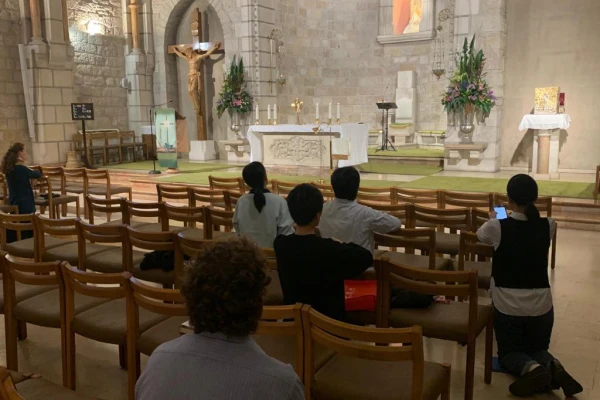
‘Adapting to the reality of the situation’
The United Nations issued a press release on Tuesday evening stating that “a staggering” 4,200 people have been killed and “over 1 million people [have been] displaced in just 10 days” of fighting between Israel and Hamas.
As the war rages on, prospective tour groups from the United States face a waiting game as they attempt to assess when it will be safe to go to the Holy Land on pilgrimage again.
Steve Ray, a Catholic convert and speaker who has visited the Holy Land more than 200 times and runs a pilgrimage service, announced on his blog Oct. 17 that he and his wife are postponing their planned November and December pilgrimages until November and December 2024.
“We are adapting to the reality of the situation,” Ray wrote.
He spoke to EWTN’s Teresa Tomeo about the situation on Oct. 14, saying they originally had planned “six trips going to Israel in the next eight months.”
“We’ve gone through the cycle many times over 20 years … [but] this is bigger than it’s been in the past, and this is going to take more time, because Hamas doesn’t mind just slaughtering people,” Ray said.
‘Hopefully the Lord’s hearing our prayers’
Catholics around the world participated in a day of prayer and fasting on Tuesday, Oct. 17, at the request of the Latin Catholic patriarch of Jerusalem, Cardinal Pierbattista Pizzaballa.
U.S. bishops urged the faithful to participate, and some parishes held prayer services to bring their people together in common cause, pleading for peace.
Father Randy Dollins, pastor at St. Thomas More Parish in suburban Denver, said over 330 people turned out Oct. 17 for an improvised, candlelit liturgy to pray for peace in the Holy Land. He told CNA that numerous parishioners at St. Thomas More have been on pilgrimages to the Holy Land, giving them a personal connection to the region despite the 7,000 miles between them.
“People feel helpless. But you know, I always tell people that you’ve got your circle of influence and your circle of concern, and the only influence many of us are going to have over the Holy Land right now is to pray, because it’s outside of our ability to influence,” Dollins said.
“Hopefully the Lord’s hearing our prayers, and cooler heads can prevail.”
Pope Francis at the end of his general audience on Wednesday morning announced another worldwide day of prayer and fasting for an end to the Israel-Hamas war, on Oct. 27.






